Themed collection Covalent Drug Discovery

Introduction to the themed collection on Covalent Drug Discovery
Guest editors Keriann Backus, Zhengying Pan and Lyn Jones introduce the themed collection on Covalent Drug Discovery.

RSC Med. Chem., 2022,13, 893-894
https://doi.org/10.1039/D2MD90022J
Covalent drugs targeting histidine – an unexploited opportunity?
Targeted covalent modulation of histidine in ligand binding sites will expand the druggable proteome.

RSC Med. Chem., 2022,13, 1121-1126
https://doi.org/10.1039/D2MD00258B
A primer on harnessing non-enzymatic post-translational modifications for drug design
Our primer discusses the current issues faced when medicinal chemists try to leverage highly reactive electrophiles for drug development.
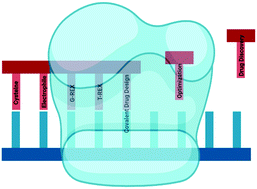
RSC Med. Chem., 2021,12, 1797-1807
https://doi.org/10.1039/D1MD00157D
Covalent PROTACs: the best of both worlds?
Covalent PROTACs combine the cutting edge research areas of targeted covalent inhibitors (TCIs) and proteolysis targeting chimeras (PROTACs).
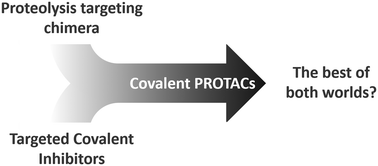
RSC Med. Chem., 2021,12, 1452-1458
https://doi.org/10.1039/D1MD00191D
Nitriles: an attractive approach to the development of covalent inhibitors
This review highlights the roles of nitriles in covalent inhibitors, their reactivity, examples of pharmaceuticals containing the cyano group and recent developments of nitrile-based inhibitors.
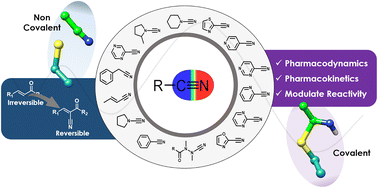
RSC Med. Chem., 2023,14, 201-217
https://doi.org/10.1039/D2MD00204C
Advanced approaches of developing targeted covalent drugs
This review highlights developing strategies of covalent drug discovery and successful applications to address challenges of designing effective covalent drugs.
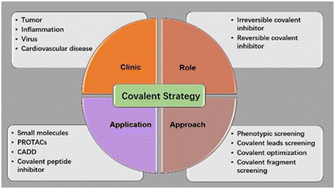
RSC Med. Chem., 2022,13, 1460-1475
https://doi.org/10.1039/D2MD00216G
Recent applications of covalent chemistries in protein–protein interaction inhibitors
Often, large molecules are required to effectively disrupt protein–protein interactions (PPIs). Exploiting covalent chemistries may realize potent therapeutics boasting more “drug-like” properties with longer residence times.
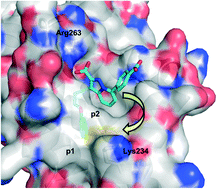
RSC Med. Chem., 2022,13, 921-928
https://doi.org/10.1039/D2MD00112H
Reactivity-based chemical-genetic study of protein kinases
In this review, we describe the development and application of chemical-genetic strategies that feature the use of covalent inhibitors targeting cysteine residues to dissect the cellular functions of individual protein kinases.
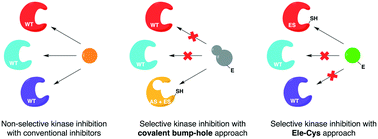
RSC Med. Chem., 2022,13, 783-797
https://doi.org/10.1039/D1MD00389E
Covalent cannabinoid receptor ligands – structural insight and selectivity challenges
X-ray crystallography and cryogenic electronic microscopy have provided significant advancement in the knowledge of GPCR structure and have allowed the rational design of covalent GPCR ligands.

RSC Med. Chem., 2022,13, 497-510
https://doi.org/10.1039/D2MD00006G
β-Lactam antibiotic targets and resistance mechanisms: from covalent inhibitors to substrates
Overview of β-lactam antibiotics and the proteins with which they covalently interact, focusing on penicillin-binding proteins and serine β-lactamases.
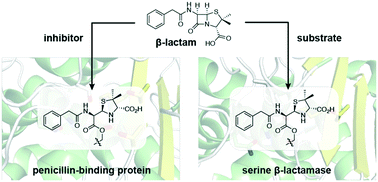
RSC Med. Chem., 2021,12, 1623-1639
https://doi.org/10.1039/D1MD00200G
Recent advances in the development of covalent inhibitors
This is the short review focusing on recent advances of covalent warheads that can be applied to the development of potential covalent inhibitors.

RSC Med. Chem., 2021,12, 1037-1045
https://doi.org/10.1039/D1MD00068C
The war on hTG2: warhead optimization in small molecule human tissue transglutaminase inhibitors
This systematic structure–activity relationship study provides key insights into warhead design and application for optimizing efficiency, selectivity, and pharmacokinetic stability of hTG2 inhibitors.
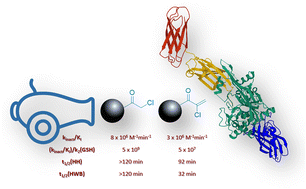
RSC Med. Chem., 2023,14, 277-298
https://doi.org/10.1039/D2MD00378C
Integrating a covalent probe with ubiquicidin fragment enables effective bacterial infection imaging
A covalent probe attached to the UBI antimicrobial peptide enhances membrane binding retention time through iminoboronate formation, thus improving bacterial infection imaging in vivo.
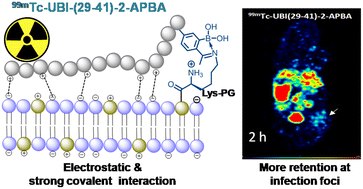
RSC Med. Chem., 2022,13, 1239-1245
https://doi.org/10.1039/D2MD00190J
Development of subtype-selective covalent ligands for the adenosine A2B receptor by tuning the reactive group
Selectivity of covalent ligands for the adenosine A2B receptor was induced by tuning the reactivity and orientation of the warhead.
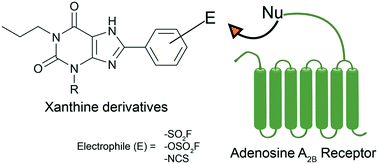
RSC Med. Chem., 2022,13, 850-856
https://doi.org/10.1039/D2MD00132B
Structure–activity relationships of hydrophobic alkyl acrylamides as tissue transglutaminase inhibitors
Our investigation of small, irreversible TG2 inhibitors identifies key components that confer enhanced efficiency, and reveals potential discrepancies in the use of current crystallographic models for predicting inhibitor potency.

RSC Med. Chem., 2022,13, 413-428
https://doi.org/10.1039/D1MD00382H
Identification of the first structurally validated covalent ligands of the small GTPase RAB27A
A novel Rab27A construct enables elucidation of covalent ligand binding, paving the way for structure-guided approaches against this challenging target.
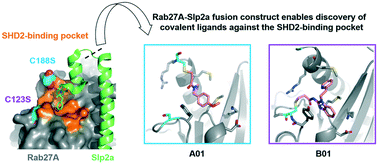
RSC Med. Chem., 2022,13, 150-155
https://doi.org/10.1039/D1MD00225B
Covalent sortase A inhibitor ML346 prevents Staphylococcus aureus infection of Galleria mellonella
Covalent sortase A inhibitor ML346 prevents Galleria mellonella from Staphylococcus aureus infection by interfering in the transpeptidation activity of sortase A for anchoring surface proteins into staphylococci envelope.
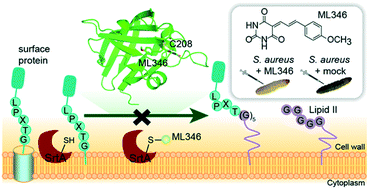
RSC Med. Chem., 2022,13, 138-149
https://doi.org/10.1039/D1MD00316J
Profiling MAP kinase cysteines for targeted covalent inhibitor design
The knowledge of reactive cysteine locations is valuable for targeted covalent inhibitor design. Here we used an advanced molecular simulation tool to assess and rationalize the cysteine reactivities for all 14 MAP kinases.
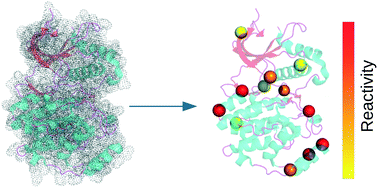
RSC Med. Chem., 2022,13, 54-63
https://doi.org/10.1039/D1MD00277E
Activity-based protein profiling reveals deubiquitinase and aldehyde dehydrogenase targets of a cyanopyrrolidine probe
We report the characterization of a UCHL1 covalent inhibitor based on a thiazole cyanopyrrolidine scaffold and a closely-related activity-based probe (ABP) which was used to generate a quantitative profile for on- and off-targets in human cells.
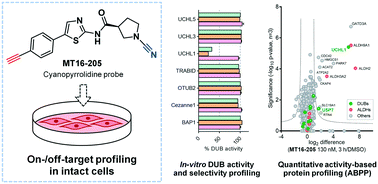
RSC Med. Chem., 2021,12, 1935-1943
https://doi.org/10.1039/D1MD00218J
Peptidomimetic nitrile warheads as SARS-CoV-2 3CL protease inhibitors
This article describes peptidomimetic SARS-CoV-2 3CLpro inhibitors with a nitrile warhead with in vitro antiviral inhibition. Superior selectivity was observed for the nitrile warhead compared to the aldehyde against 3 human cathepsins (B, S and L).
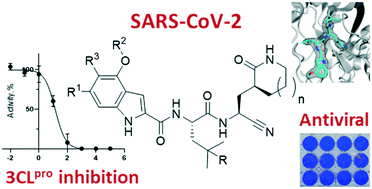
RSC Med. Chem., 2021,12, 1722-1730
https://doi.org/10.1039/D1MD00247C
Deglycase-activity oriented screening to identify DJ-1 inhibitors
Tracking the esterase activity of DJ-1 via a fluorescent-based scalable assay to uncover and develop candidates with enhanced potency.

RSC Med. Chem., 2021,12, 1232-1238
https://doi.org/10.1039/D1MD00062D
Irreversible inhibition of BoNT/A protease: proximity-driven reactivity contingent upon a bifunctional approach
A proximity-driven covalent bond with intrinsically less reactive warheads has been made possible by using a metal-chelating anchor for directed targeted covalent modification of Cys165 within the BoNT/A protease.
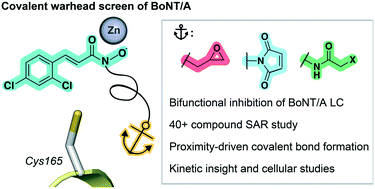
RSC Med. Chem., 2021,12, 960-969
https://doi.org/10.1039/D1MD00089F